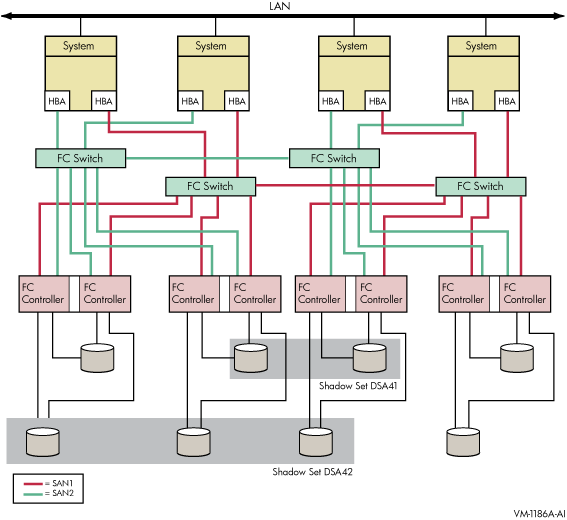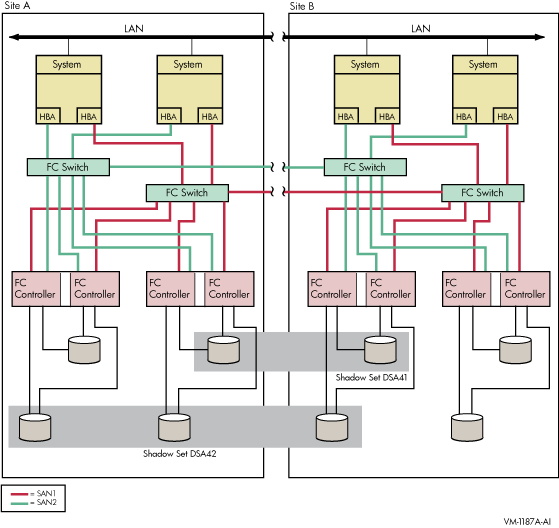Shadow Set Configurations
To illustrate the various levels of data availability obtainable through Volume Shadowing for OpenVMS, this section provides a representative sample of hardware configurations. Figure 2-2 through Figure 2-4 show possible system configurations for shadow sets. The hardware used to describe the sample systems, while intended to be representative, is hypothetical; they must be used only for general observations about availability and not as a suggestion for any specific configurations or products.
In all the following examples, the shadow set members use the $allocation-class$ddcu: naming convention. The shadow set (also known as the virtual unit) is represented by DSAn:, where n represents a number between 0 and 9999. These naming conventions are described in more detail in “Creating a Shadow Set ”.
Figure 2-2 shows an OpenVMS Cluster system consisting of two systems connected to the same two shadow sets. Each system has two host-based adapters (HBAs) connecting it to the same two Fibre Channel (FC) switches. In turn, the FC switches are connected to two dual controllers, which are connected to two shadow sets.
Each shadow set member is connected by two paths, one to each of the dual controllers of one storage system. Each shadow set member can fail over between controllers independently of each other. Each system can access both shadow sets by direct connections.
This configuration provides coverage against:
Media errors
Failure on one system
Failure of one HBA per system
Failure of one or more controllers
Failure of one disk per shadow set
Figure 2-3 shows an OpenVMS Cluster system consisting of four systems. Each system in the cluster is identical to each system shown in Figure 2-2. In addition to the protection offered by Figure 2-2, this OpenVMS Cluster configuration provides greater protection from:
Component failure because there are twice as many components
Failure of one or two devices in shadow set DSA42 because it is a three-member set
This type of configuration provides continued access to data in spite of the failure of any one or more of these systems or switches.
Figure 2-3 OpenVMS Cluster System With Four Systems, Four FC Switches, Four Dual Controllers, and Two Shadow Sets
 |
Figure 2-4 shows an OpenVMS Cluster system identical to Figure 2-3 except that the four systems are not in a single location. Instead, two systems are at one site and two at a second site. This figure illustrates how you can shadow data disks over long distances. Members of each shadow set are configured between two distinct and widely separated locations — a multiple-site OpenVMS Cluster system. The OpenVMS systems and shadowed disks in both locations function together as a single OpenVMS Cluster system and shadow set configuration. If a failure occurs at either site, the critical data is still available at the remaining site.

